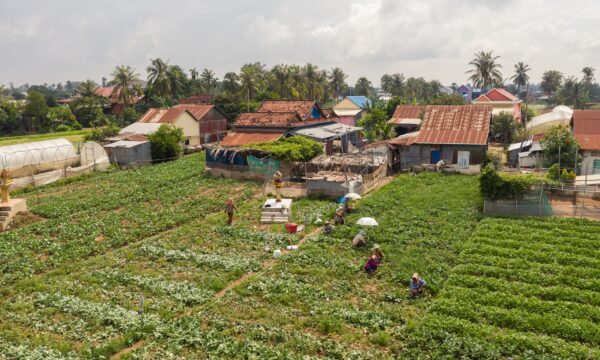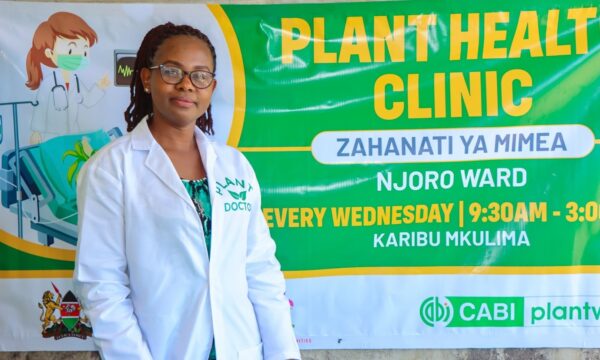In 2018 and 2019, CABI launched two innovative decision-support tools for identifying pest risks. They are the Horizon Scanning Tool (HST) and the Pest Risk Analysis (PRA) Tool, both of which are used in PlantwisePlus capacity building activities. They help users identify potential future pest threats, especially those working in areas like plant protection and biosecurity.
Since their introduction, the tools have evolved. They have become indispensable resources in the ongoing battle against plant health threats. In 2023, CABI published a working paper assessing the usage and impact of these decision-support tools. In this blog, we take a look at the tools and key findings of the paper.
The evolution of CABI’s pest risk decision-support tools
The origin of the tools goes back to 2015. This was the year that CABI commissioned research into information for invasive species management. CABI wanted to understand how four key groups prefer to access and use invasive species information online. These groups were:
- Plant protection officers
- Risk assessors
- Quarantine officers
- Protected area managers
When surveyed, all of the groups highlighted the need for expert-system support for pest prioritization and risk analysis. CABI’s response was to develop the HST and PRA Tool.

Horizon scanning
CABI launched the HST in 2018. Horizon scanning is a systematic process for identifying potential invasive species and plant pest threats. The tool provides a quick and user-friendly means of identifying and prioritizing potential invasive species for further inquiry. It focuses on harmful species that are not present but which might enter selected geographical areas.
Pest risk analysis

Also in 2018, CABI began development of the PRA Tool. The tool was prototyped in 2018 and fully launched in 2019. It uses crop and pest data from the CABI Compendium. It generates commodity pest lists and provides links to pest datasheets. The lists enable users to assess the likelihood of pest entry. The tool also provides a template to help determine how likely a pest is to establish, spread and impact its environment. Then, if required, users can select appropriate measures to reduce the risk of introduction. The tool helps users to produce a PRA report which includes the scientific evidence for setting import conditions or regulating pests.
Working paper gives insights into tools’ usage
Biosecurity is a challenging and rapidly changing field of research and work. So, CABI has continued to make enhancements to improve the tools’ design and technical content. On the basis of user feedback, CABI made upgrades, making the tools more efficient and user-friendly.
Although used globally, studies documenting the impact of the tools’ usage are limited. CABI was interested to know how the tools were being used. Both immediate and long-term insights are valuable for shaping tool development. Throughout 2021 and 2022, CABI gathered data about their usage and in 2023, scientists published a working paper. It gave valuable insights into the tools’ benefits and their impact.
The global impact of pest risk tools
Both tools are used worldwide. The PRA Tool, in particular, was aimed at lower-income countries that might not have well-developed PRA processes in place. CABI raises revenues through subscriptions and funded projects. In so doing, the tools can be provided for free to National Plant Protection Organisations (NPPOs) in lower-and middle-income countries. CABI currently offers free subscriptions to NPPOs in 117 countries. This also enables their PRA teams to access the complete set of crop and pest datasheets in the CABI Compendium.

The HST and PRA Tool have become valuable knowledge resources across the globe. However, their impact is particularly pronounced in lower-income countries of the global south. Between March 2021 and March 2022, the majority of HST users came from Asia (33% of all users). During the same timeframe, the majority of PRA Tool users came from Africa (44%). The tools support CABI’s goal of levelling the playing field in plant health.
Real-world benefits of using the tools

For both the HST and the PRA Tool the results are not an end in itself. The paper helped CABI understand the type of “linked” actions that subscribers or users have taken due to using the tools. In so doing, the study aimed to provide insights into real-world usage of the tools. The most common follow-on activities after using the HST included, for example:
- research (17%);
- surveillance (15%); and
- pest risk analysis (13%).
Real-world examples from Ghana and Zambia illustrated the practical benefits of the PRA Tool. Case studies showed how the tool has been integrated into the workflow of some NPPOs. It effectively replaced cumbersome paper-based questionnaires. In Ghana, the PRA Tool has become the main tool used for pest risk assessments. In both countries, the tools enhanced pest risk assessment practices.
Using the tools to support policy development and trade
The study also revealed impacts on policy development and trade. A PRA can provide justification for government policy actions. In Ghana, for example, the results of a PRA were used to impose a ban on tomatoes imported from Morocco. This was done to help reduce the risk of introducing the Tomato torrado virus.
Also in Ghana, the HST was used to identify potential pest threats. A scan led to a nationwide survey for high-ranking pests present in neighbouring countries. The aim was to discover if, in fact, the potential pests were already present in Ghana. The surveyed pests included, among others, melon thrips, vegetable leaf miner and American serpentine leaf miner. While melon thrips was absent, both miners were confirmed. The negative result for melon thrips was used to inform European Union trade negotiations.
Usage challenges and future benefits

The working paper highlighted the potential of these tools and the access they provide to pest and crop information. But it also revealed one particular challenge: internet dependency. In regions with poor connectivity, the tools face some limitations in their use. This emphasizes the need for solutions to bridge the digital divide. And while both tools produce outputs for offline working, CABI is investigating further improvements when there is limited internet.
CABI’s HST and PRA Tool have proved to be of great value in the global biosecurity landscape. Their evolution and positive impact on lower-income countries highlight their critical role. As climate change worsens the spread of pests, their integration into policy and practice can be beneficial. The tools can help to safeguard plant health and mitigate pest risks worldwide.
Download the working paper: Assessment of the use of CABI’s decision support tools for biosecurity – Pest Risk Analysis Tool and Horizon Scanning Tool
Learn more about these and other digital resources from PlantwisePlus here.
Pest risk training to help detect Pakistan’s potential invaders
Horizon scanning and pest risk analysis of prioritized pests in Bangladesh
CABI facilitates Pest Risk Assessment writeshop in Nepal
CABI Book: Plant pest risk analysis: concepts and application
PlantwisePlus gratefully acknowledges the financial support of the Directorate-General for International Cooperation (DGIS), Netherlands; European Commission Directorate General for International Partnerships (INTPA, EU); the Foreign, Commonwealth & Development Office (FCDO), United Kingdom; the Swiss Agency for Development and Cooperation (SDC) Switzerland; the Australian Centre for International Agricultural Research (ACIAR); the Ministry of Agriculture of the People’s Republic of China (MARA)
1 Comment
Leave a Reply
Related News & Blogs
Pest preparedness in action: Preventing the coconut hispine beetle invasion in Bangladesh
The coconut hispine beetle (Brontispa longissima) is a destructive pest of palms, including coconut palms. It is a major pest in Southeast Asia, the Pacific and parts of South Asia. For several years, Bangladesh has recognized the potential threat that…
2 June 2025





I am conducting PRA